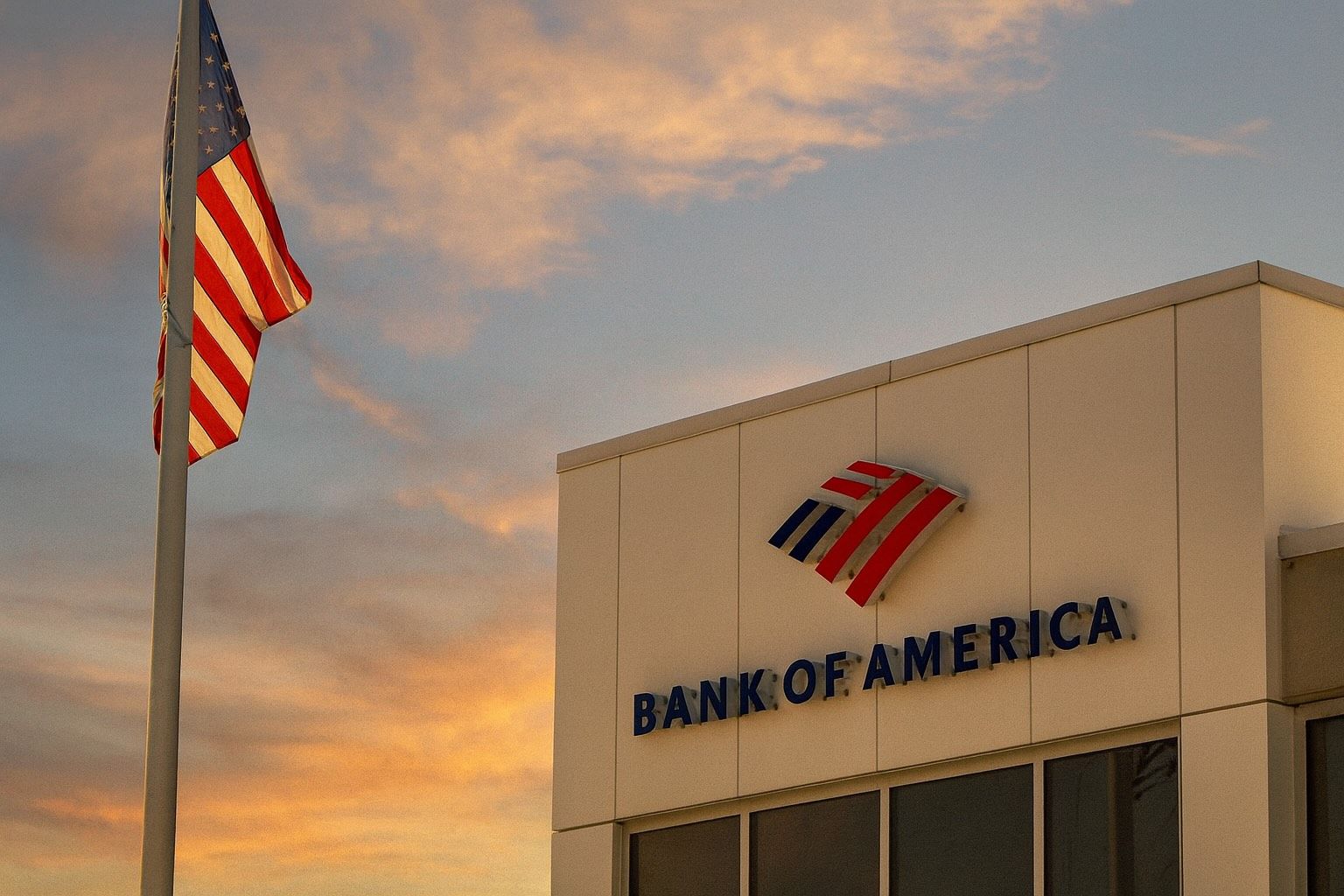- Stock Volatility: Bank of America’s stock (NYSE: BAC) is hovering around $50 per share as of midday Oct. 17, 2025. Shares opened at $50.38 on Friday [1] and are down roughly 1.5% in intraday trading amid a sector-wide downturn [2]. This dip follows a 3.5% tumble on Thursday to $50.44 [3], which erased an initial post-earnings rally earlier in the week.
- Earnings Beat Expectations: BofA reported third-quarter 2025 earnings far above Wall Street estimates. Net income jumped to $8.5 billion (EPS $1.06) from $6.9 billion a year ago [4], topping the $0.95 EPS consensus. Revenue came in around $28.1 billion (up ~11% YoY [5]), bolstered by a 43% surge in investment banking fees as dealmaking rebounded [6]. The strong results initially sent BAC stock up about 5% in early trading Wednesday [7].
- Upgraded Outlook: Bank of America raised its guidance for interest income going forward. It now projects Q4 net interest income of ~$15.6–$15.7 billion (about 8% higher than last year) [8] thanks to solid loan and deposit growth. CEO Brian Moynihan noted “record net interest income” in Q3 driven by “strong loan and deposit growth” and effective balance sheet positioning [9]. The bank also boosted its quarterly dividend by 8% (to $0.28/share) after passing Fed stress tests [10] [11], and it has a $40 billion share buyback authorization in place [12] – signaling confidence in future earnings and cash flow.
- Analysts Bullish Despite Jitters: Wall Street remains broadly positive on BAC. Multiple firms raised price targets after earnings: for example, Barclays hiked its target from $54 to $59 (Overweight) and Citigroup upped its target to $62 (Buy) [13] [14]. Morgan Stanley recently boosted its BAC price objective to $67 with an Overweight rating [15]. In total, 21 analysts rate BAC a “Buy” versus just 5 Holds, with the average 12-month target around $56 – roughly 12% above current levels [16].
- Peers & Sector Context: Rival mega-banks JPMorgan, Wells Fargo, and Citigroup also posted strong Q3 profits this week, aided by booming investment banking [17]. BAC’s stock is up ~14% year-to-date – slightly lagging those peers and the broader bank index [18] – but its recent earnings beat has helped it “catch up” to larger-cap rivals [19]. However, sector sentiment turned cautious late in the week after two regional banks disclosed bad loan losses, spooking investors. BofA shares slid ~1.8% in Friday’s early trade alongside declines in other big banks [20], as traders reacted to credit quality concerns in parts of the banking industry.
Real-Time Price Check: BAC Slips After Initial Rally
After a mid-week surge on earnings, Bank of America’s stock has seesawed amid broader market swings. As of midday Friday (Oct. 17), BAC traded around the $50 mark, down about 1–2% on the day [21]. The stock opened at $50.38 and showed modest volatility through the morning [22]. This minor pullback comes on the heels of a sharp drop on Thursday, when BAC plunged 3.5% to close at $50.44 [23]. That decline essentially wiped out the gains from Wednesday, when shares jumped roughly 4–5% following the earnings announcement [24].
The choppy trading reflects a mix of company-specific news and sector-wide sentiment. Earlier in the week, optimism ran high – BAC briefly traded near its 52-week high (~$52.88) after posting stellar results. By Friday, however, macro jitters took hold (more on that below), applying downward pressure on bank stocks broadly. Still, at roughly $50, BofA’s stock remains about 15% higher year-to-date, and it sits just under its 50-day moving average (~$50) and well above the 200-day average (~$46) – a sign that the longer-term uptrend remains intact [25].
Blockbuster Q3 Earnings Fuel Optimism
Bank of America’s third-quarter 2025 earnings blew past expectations, showcasing strength across its core businesses. The bank earned $1.06 per share, handily topping analyst forecasts of roughly $0.94–$0.95 [26]. Profit jumped 31% from a year earlier to $8.5 billion, while revenue climbed about 10–11% to $28.1 billion [27]. CEO Brian Moynihan hailed the quarter as a “well-rounded beat,” highlighting that “strong loan and deposit growth, coupled with effective balance sheet positioning, resulted in record net interest income” [28]. In fact, net interest income (the spread between loan yields and deposit costs) hit an all-time high of roughly $15.2 billion, up ~9% year-on-year [29].
A major driver was renewed dealmaking activity. Bank of America’s investment banking division had a breakout quarter, with fees surging 43% to $2.0 billion [30]. Companies are regaining confidence to pursue large mergers and acquisitions, and BofA benefited more than expected from this resurgence. Management had only forecast a 10–15% rise in IB fees, so the actual result was nearly triple that outlook [31]. “[This] was just a well-rounded beat,” said David Wagner of Aptus Capital, adding that BAC’s performance is now “catching up to [its] larger-cap peers” on a year-to-date basis [32]. He praised CEO Moynihan and Bank of America as a “north star” for spotting consumer trends ahead of rivals [33].
Other segments also delivered. Trading revenue held up well (helped by market volatility), and consumer banking remained solid. Importantly, credit quality improved slightly – BofA trimmed its provisions for credit losses to $1.3 billion in Q3, down from $1.6 billion last quarter [34]. This echoed similar trends at peers (Wells Fargo likewise reduced reserves after seeing stable loan performance) [35]. In short, the quarter showcased broad-based strength, from Wall Street advisory fees to Main Street lending.
New Developments: Guidance Upgrade and Shareholder Returns
Alongside the earnings beat, Bank of America gave investors more reasons for optimism about the future. The bank upgraded its outlook for net interest income in the coming quarter, signaling confidence that it can keep growing revenue despite changes in interest rates. BofA now expects to generate around $15.6–$15.7 billion of NII in Q4, which would be about an 8% increase year-on-year [36]. This improved forecast comes even after the Federal Reserve cut interest rates by 0.25% in September, a move that typically pressures banks’ lending margins. CFO Alastair Borthwick explained that robust economic conditions – low unemployment, steady wage growth, healthy home prices, and a strong stock market – are fueling loan demand and offsetting the slight rate decrease [37]. These factors likely account for the strong performance in both consumer and commercial banking, Borthwick noted [38].
Bank of America’s management is also returning more capital to shareholders, reflecting its healthy position. In late June, BofA easily passed the Fed’s annual stress tests, and in response it hiked its quarterly dividend from $0.26 to $0.28 per share (an 8% increase) [39] [40]. The higher dividend was first paid out in late September and brings the stock’s yield to roughly 2.2% [41]. Additionally, the board authorized a massive $40 billion stock buyback program (announced in July), giving BofA the capacity to repurchase up to 11% of its outstanding shares [42]. Such buybacks can boost future earnings per share and signal that management views the stock as undervalued. BofA has already been actively buying back stock, returning a total of $7.4 billion to shareholders in Q3 via buybacks and dividends [43] [44]. These moves underscore the bank’s solid capital position – common equity Tier 1 ratios are comfortably above regulatory minimums – and its confidence in sustaining earnings growth.
There have been no major executive shake-ups or regulatory penalties at BofA in recent days, so the focus remains on execution and financial results. One noteworthy item: BofA’s treasury department announced the redemption of $2.5 billion in senior notes due 2026 (essentially an early debt payoff) as part of routine capital management. Overall, regulators have kept a close eye on the banking sector’s stability, but BofA’s strong stress test results and rising capital return suggest it is navigating the environment well. Still, the bank, like its peers, faces upcoming tighter capital requirements under proposed regulatory changes – an industry-wide development that could require big banks to hold more equity in the coming years (a point to watch as rules are finalized).
Analyst Insights: “Buy” Ratings and Cautious Optimism
Wall Street analysts and investors reacted positively to Bank of America’s Q3 performance, while also keeping an eye on broader economic risks. As noted, virtually every major analyst covering BAC has a bullish outlook on the stock. According to MarketBeat data, 21 analysts rate BAC a Buy and 5 rate it Hold, with no Sell ratings at present [45]. The consensus price target is around $56–57, about 12% above the current share price [46]. Many banks have raised their forecasts for BofA after the latest earnings: for instance, Morgan Stanley recently boosted its price target to $67 (up from a prior $66) while reiterating an Overweight recommendation [47]. Barclays lifted its target to $59 and Evercore ISI to $57, both citing BofA’s stronger earnings trajectory [48]. Even Citigroup’s equity research team – historically cautious on some rivals – upped their target to $62 with a Buy rating [49]. Such moves suggest growing confidence that BofA can deliver solid growth despite a mixed economic backdrop.
Analysts were impressed by the earnings beat and what it implies for BofA’s strategy. “Strong loan and deposit growth… resulted in record NII,” CEO Moynihan emphasized, pointing to core drivers of profitability [50]. Peter Torrente, KPMG’s U.S. banking sector lead, noted that big banks overall are managing to stay “on an even keel” amid economic volatility, thanks to rising deal activity and a clearer outlook on Fed policy [51]. However, he added that continuous vigilance is needed: monitoring interest rate trends and consumer health “remains crucial as banks head into the final months of the year” [52]. In other words, analysts see BofA’s current momentum as durable but are mindful that factors like Fed decisions, loan defaults, or recession risks could alter the picture.
Outside voices are similarly optimistic yet vigilant. “This was just a well-rounded beat,” said Aptus Capital’s David Wagner, praising BofA’s ability to finally narrow the gap with peers on stock performance [53]. He specifically called out Moynihan’s knack for reading consumer behavior early [54] – a valuable asset as the bank navigates changing trends in spending and borrowing. At the same time, legendary investors have offered words of caution. Notably, Warren Buffett remains BofA’s largest individual shareholder (Berkshire Hathaway owns about 605 million BAC shares, an ~8% stake) and has long been bullish on the franchise [55]. But even Buffett trimmed his BAC holdings by roughly 10% earlier this year [56], a move some interpret as simple profit-taking near highs, and others see as a sign to “proceed with caution” after the stock’s strong run [57] [58]. In general, sentiment toward Bank of America is positive but not euphoric – analysts largely agree the stock is attractive relative to fundamentals, yet many stress that prudent risk management (both by the bank and its investors) will be key going forward.
Comparison to Peers: Catching Up in 2025
In the big-bank league tables, Bank of America’s latest results reinforce its standing as a solid performer, even if its stock has lagged a bit behind rivals this year. Year-to-date, BAC shares are up about 14% (as of mid-October), slightly underperforming the KBW Bank Index and peers like JPMorgan Chase (+19% YTD) and Citigroup (+17%) [59] [60]. That gap had widened earlier in 2025, but BofA’s strong third quarter helped narrow it. “The stock’s performance is catching up to some of the other larger-cap peers,” noted Wagner, the Aptus Capital portfolio manager [61]. Indeed, Wednesday’s post-earnings pop briefly put BAC near its highest price of the past two years, around $52. And even after pulling back, the stock is within ~4% of its 52-week high, indicating it has recouped much of the ground lost during bouts of market volatility.
All major U.S. banks have benefited from a rebounding economy in 2025, but each has its nuances. JPMorgan, the nation’s largest bank, also beat Q3 profit forecasts, powered by record trading and steady consumer banking results [62]. Wells Fargo saw growth in its lending business and reduced credit reserves (similar to BofA) [63]. Citigroup impressed with strong investment banking and wealth management fees. Yet, Bank of America’s balance of businesses (from Main Street deposit accounts to Wall Street trading desks) seems to be firing on all cylinders now. BofA’s 43% jump in deal fees even outpaced some peers – a notable feat for a bank that has long been more retail-focused compared to, say, Goldman or Morgan Stanley. This suggests BofA is successfully capitalizing on the M&A rebound.
Investors often compare BofA and JPMorgan as the two diversified giants. On several metrics, JPMorgan still has an edge – for example, JPM’s return on equity and profit margins have been higher. But BofA is closing the gap: its Q3 return on tangible common equity hit about 15.4%, approaching JPM’s level [64]. Efficiency ratio (expenses as a share of revenue) improved to under 62% for BofA, not far from JPM’s efficiency. And BofA’s massive deposit base ($2 trillion+) and lending franchise mean it benefits greatly from rising interest rates, arguably more so than peers that rely heavily on investment banking. This was evident in 2025 as the Fed’s high rates swelled BofA’s net interest income to records. Now, as rates potentially peak and even tick down, questions arise: will BofA’s interest income momentum fade faster than peers’? Or will loan growth and fee businesses pick up the slack? So far, the bank’s updated guidance (still expecting ~8% NII growth in Q4) [65] and its balanced performance indicate it can navigate the shift as well as – if not better than – rivals.
In terms of stock valuation, Bank of America trades at around 1.3 times book value and 9-10 times forward earnings [66] [67]. This is a modest discount to JPMorgan’s valuation, reflecting the market’s perception of JPM as the higher-quality franchise. However, BofA bulls argue the gap is overdone given BofA’s improving returns and scale. With a dividend yield now above 2% and a huge buyback in play, shareholder returns could exceed those of peers if the stock price appreciates as analysts predict. In summary, BofA might not have led the pack in stock performance early in the year, but its strong Q3 and proactive management moves (like raising the dividend and NII guidance) have strengthened its standing relative to JPM, Citi, Wells Fargo, and others going into year-end.
Forecast and Technical Picture: Where Is BAC Headed?
Looking ahead, short-term technical indicators for BAC stock are mixed after the recent volatility. The shares have been trading in the upper end of their range, notching a 52-week high of ~$52.88 earlier this month [68]. The rally into earnings pushed momentum gauges near overbought levels, but the subsequent pullback released some of that pressure. Currently, the 14-day RSI (Relative Strength Index) is ~50 – smack in the middle of its range [69] – suggesting neither overbought nor oversold conditions. The stock is hovering right around its 50-day moving average (~$50), which has acted as a support level in recent weeks [70]. A sustained move below $50 could signal a short-term trend reversal, whereas a bounce higher would keep the uptrend intact. Traders are watching the $52-$53 resistance zone (recent highs) and support around $48 (roughly the low after earnings) for clues on BAC’s next direction.
On a longer horizon, fundamental indicators and forecasts paint an encouraging picture for Bank of America, albeit with some caveats. Wall Street analysts project full-year 2025 earnings of about $3.7 per share [71], which would mark roughly 20% growth over 2024’s earnings – an impressive clip for a banking behemoth. Revenue for the full year is expected to top $110 billion [72]. The bank’s ability to hit these targets will depend on a few key factors:
- Interest Rate Trajectory: With the Federal Reserve possibly nearing the end of its rate-hiking cycle (and even contemplating rate cuts in 2025), banks face a double-edged sword. Lower rates could compress net interest margins, but they also tend to stimulate loan demand and ease funding costs. BofA’s management actually sees rate cuts boosting loan growth – they noted that September’s Fed cut should “stoke demand from borrowers” [73]. In fact, futures markets are pricing in a high likelihood of another Fed cut by December [74]. If that occurs, BofA expects it can still grow NII by mid-single digits percent next year [75], thanks to its large, low-cost deposit base (nearly $2 trillion) and the potential for refinancing activity. Nonetheless, investors will be watching the Fed’s moves closely, as the pace of rate changes in 2025 will influence all bank earnings.
- Loan Quality and Economy: Thus far, U.S. consumers and businesses have been relatively resilient. Unemployment remains low and consumer spending is steady, which bodes well for credit card payments, mortgages, and business loans. BofA’s Q3 saw a drop in credit loss provisions, indicating it isn’t seeing major deterioration in loan repayments [76]. But some caution lights are blinking. For instance, pockets of stress in commercial real estate and auto lending have emerged (one high-profile auto lender, Tricolor, went bankrupt last month amid subprime loan losses [77] [78]). BofA’s CFO Borthwick addressed one such case – the bankruptcy of First Brands, an auto parts maker – assuring that BofA’s loan exposure there is “backed by strong collateral” and adequately reserved for [79]. Going forward, if the economy slows or if more bad loans crop up in the industry, banks might have to raise loan loss reserves again, which would cut into profits. Analysts will monitor credit card delinquency rates, corporate default rates, and any guidance from BofA on loan quality. So far, the bank appears well-prepared: its balance sheet has nearly $960 billion in liquidity to withstand shocks [80] [81], and its capital ratios are robust.
- Market Sentiment & External Risks: Banks don’t operate in a vacuum – broad market sentiment can swing bank stocks more than fundamentals at times. We saw an example of that this week: despite stellar earnings, bank stocks sold off due to unrelated regional bank woes. On Thursday, two mid-sized lenders (Zions Bancorp and Western Alliance) revealed unexpected loan losses and alleged fraud issues, which spooked investors about potential “souring loans” elsewhere [82] [83]. “All these could be isolated incidents, but there are increasing concerns about bad credit,” said Neil Wilson, a strategist at Saxo Markets, noting a “pretty nasty little cocktail” of worries prompting a risk-off mood [84]. For BofA, such episodes mean its stock can be buffeted by news that isn’t directly tied to its own performance. Moreover, ongoing geopolitical tensions or an economic downturn would likely drag on bank stocks generally. On the flip side, if inflation continues cooling and the Fed gently eases policy, it could provide a Goldilocks scenario for banks – moderate growth, lower funding costs, and stable asset quality. Bank of America’s own researchers have voiced optimism, even predicting a scenario where gold prices might spike as a hedge if monetary easing accelerates [85] [86] (a sign that the bank is thinking about various outcomes).
In summary, the outlook for BAC appears favorable but not without challenges. The bank’s solid fundamentals, diversified income streams, and tech investments (like its new AI tools to enhance efficiency) position it well for the coming year. Many experts expect Bank of America to “sustain double-digit growth next year” if the economy stays on track and the Fed’s moves are measured [87] [88]. Still, the recent market hiccups remind investors to stay vigilant. Bank of America’s stock may have more room to run – with analysts targeting mid-$50s or higher – but its trajectory will likely mirror the broader story of 2025: navigating the tail end of the rate cycle, keeping credit risks in check, and leveraging any economic tailwinds that emerge.
Investor Sentiment: Cautiously Positive
The prevailing investor sentiment toward Bank of America can be described as cautiously positive. On one hand, the bank’s strong earnings and shareholder-friendly moves have earned it goodwill. It’s telling that famed value investor Warren Buffett remains a major stakeholder – BofA is the #4 holding in Berkshire Hathaway’s portfolio [89] – which many retail investors take as an endorsement of the bank’s long-term value. BofA’s relatively low valuation multiples compared to its own history and to peers also attract value-focused investors. As noted, the stock’s price-to-earnings and price-to-book ratios are reasonable given its growth (P/E around 10, P/B ~1.3 [90]), and analysts argue the market has not fully “re-rated” BofA for its improved profitability [91]. This suggests potential upside if the bank continues executing well.
At the same time, there is an undercurrent of caution. The fact that Buffett trimmed his BAC stake a bit this year [92] exemplifies the take-profits mentality some large holders have after the stock’s big run from last year’s lows. Bank stocks in general are prone to swift sentiment shifts – they were out of favor in 2023 after some high-profile bank failures, then rallied strongly in 2025 as fears eased and earnings surprised to the upside. Now, with questions about the late-cycle economy and how banks will fare if interest rates decline, some investors are hesitant to chase bank stocks at multi-year highs. Institutional ownership in BAC remains high (over 70% of the float [93]), but flows can reverse if macro data deteriorates.
The mood in the market at this very moment is a bit unsettled due to the late-week credit scare. “Storm clouds” might be too strong a term, but as Richard Hunter of Interactive Investor put it, there are “increasing signs of storm clouds gathering over markets, with…a new source of concern in bad loans for US regional banks” [94]. That sentiment hit the banking sector broadly, including giants like BofA, even though BofA itself was not directly involved in the particular bad loans. Essentially, investors are navigating a “wall of worry,” balancing strong bank earnings against potential pitfalls like credit issues, geopolitics, and policy changes [95]. For now, confidence in BofA’s management is bolstering sentiment – Moynihan’s team has successfully steered through challenges and delivered consistent results, which reassures many shareholders. As long as the bank keeps executing and the economy doesn’t throw a curveball, the overall sentiment is likely to remain constructive. Investors appreciate the bank’s stability and dividends, but they’re also keeping one eye on those macro factors that could quickly change the story.
Bottom Line: Bank of America’s stock has been on a rollercoaster this week – soaring on a blockbuster earnings beat, then dipping amid broader banking jitters. The key takeaway for investors is that BofA’s underlying performance is robust: profits are up, revenue is growing, and the bank is rewarding shareholders with buybacks and higher dividends. Analysts largely agree that the stock has upside from here, especially if the economic outlook stays favorable. However, recent events show that sentiment can swing fast in the banking sector. As one strategist warned, a mix of credit worries and external risks is creating a “nasty little cocktail” of caution in the market [96]. For now, Bank of America appears well-equipped to navigate these cross-currents – acting, as one expert said, as a financial “north star” in spotting trends [97] – but investors should keep their seatbelts fastened. In plain terms, BofA is beating expectations and looking ahead optimistically, yet prudent vigilance remains wise as we watch how the rest of 2025 unfolds.
Sources: Bank of America Investor Relations [98] [99]; Reuters [100] [101] [102]; Bloomberg Law [103]; TS² / TechStock² [104] [105]; MarketBeat [106] [107]; Guardian [108]; Finviz [109].
References
1. www.marketbeat.com, 2. www.reuters.com, 3. finviz.com, 4. www.reuters.com, 5. www.reuters.com, 6. www.reuters.com, 7. www.reuters.com, 8. www.reuters.com, 9. www.reuters.com, 10. ts2.tech, 11. ts2.tech, 12. www.marketbeat.com, 13. www.marketbeat.com, 14. www.marketbeat.com, 15. www.marketbeat.com, 16. www.marketbeat.com, 17. www.reuters.com, 18. www.reuters.com, 19. www.reuters.com, 20. www.reuters.com, 21. www.reuters.com, 22. www.marketbeat.com, 23. finviz.com, 24. www.reuters.com, 25. www.marketbeat.com, 26. www.reuters.com, 27. www.reuters.com, 28. www.reuters.com, 29. www.reuters.com, 30. www.reuters.com, 31. www.reuters.com, 32. www.reuters.com, 33. www.reuters.com, 34. www.reuters.com, 35. www.reuters.com, 36. www.reuters.com, 37. www.reuters.com, 38. www.reuters.com, 39. ts2.tech, 40. ts2.tech, 41. www.marketbeat.com, 42. www.marketbeat.com, 43. ts2.tech, 44. ts2.tech, 45. www.marketbeat.com, 46. www.marketbeat.com, 47. www.marketbeat.com, 48. www.marketbeat.com, 49. www.marketbeat.com, 50. www.reuters.com, 51. www.reuters.com, 52. www.reuters.com, 53. www.reuters.com, 54. www.reuters.com, 55. ts2.tech, 56. ts2.tech, 57. ts2.tech, 58. ts2.tech, 59. www.reuters.com, 60. ts2.tech, 61. www.reuters.com, 62. www.reuters.com, 63. www.reuters.com, 64. investor.bankofamerica.com, 65. www.reuters.com, 66. finviz.com, 67. finviz.com, 68. ts2.tech, 69. finviz.com, 70. www.marketbeat.com, 71. www.chartmill.com, 72. www.chartmill.com, 73. www.reuters.com, 74. ts2.tech, 75. ts2.tech, 76. www.reuters.com, 77. www.theguardian.com, 78. www.theguardian.com, 79. www.reuters.com, 80. ts2.tech, 81. ts2.tech, 82. www.reuters.com, 83. www.reuters.com, 84. www.reuters.com, 85. ts2.tech, 86. ts2.tech, 87. ts2.tech, 88. ts2.tech, 89. ts2.tech, 90. finviz.com, 91. ts2.tech, 92. ts2.tech, 93. www.marketbeat.com, 94. www.theguardian.com, 95. www.theguardian.com, 96. www.reuters.com, 97. www.reuters.com, 98. finance.yahoo.com, 99. seekingalpha.com, 100. www.reuters.com, 101. www.reuters.com, 102. www.reuters.com, 103. news.bloomberglaw.com, 104. ts2.tech, 105. ts2.tech, 106. www.marketbeat.com, 107. www.marketbeat.com, 108. www.theguardian.com, 109. finviz.com








